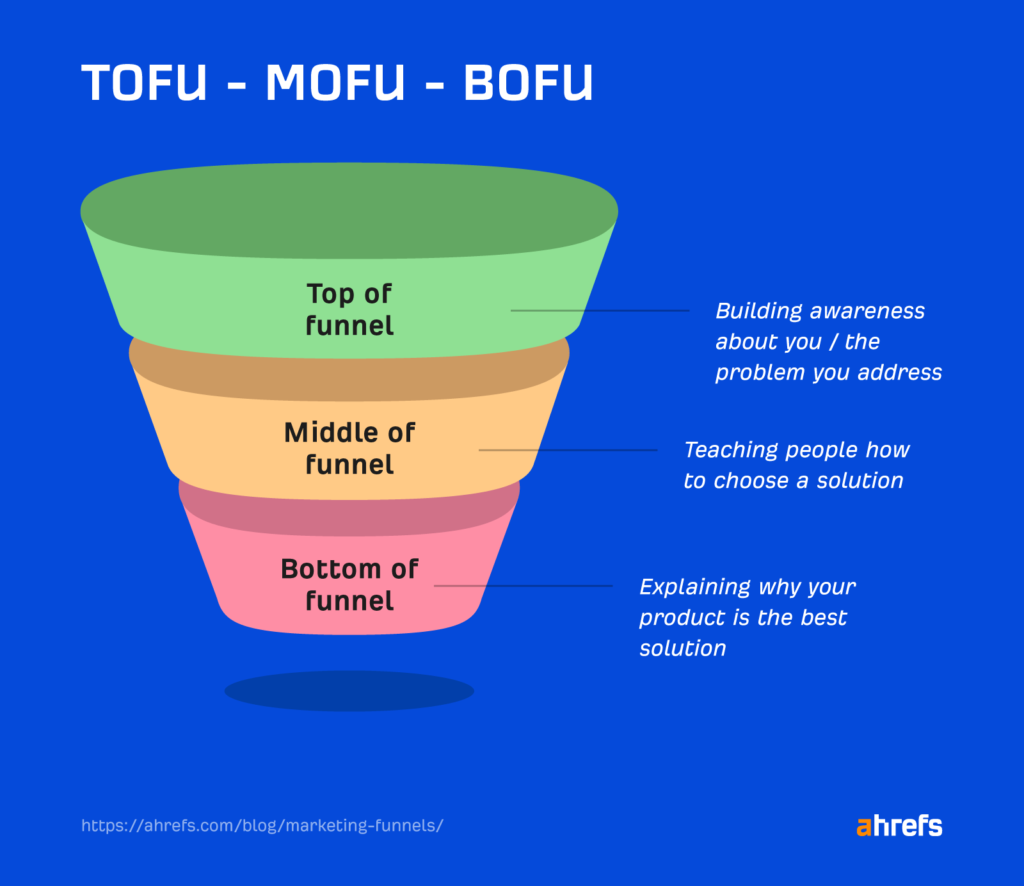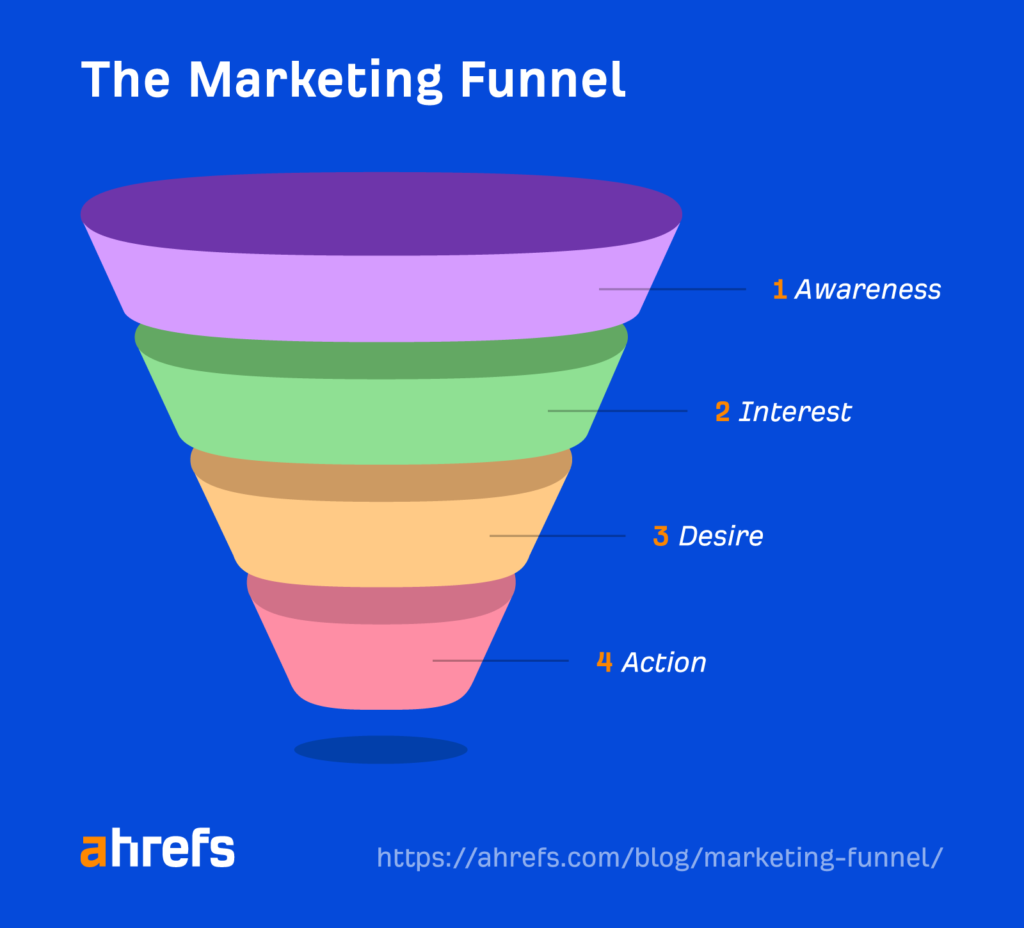To be effective in today’s fast-paced business world, a strong marketing strategy must take potential customers on a journey that culminates with them being passionate champions of your organization. The stages a consumer goes through, from awareness to conversion, are represented by a “funnel,” which is a term that is frequently used to describe this journey.
Making the most of your marketing efforts and attaining long-term success needs developing a comprehensive funnel marketing plan. This blog post will discuss the key parts and procedures to develop a successful full-funnel marketing strategy. Let’s dive in!

Understanding the Full Funnel Approach
The complete funnel marketing approach covers the whole customer journey—from when a potential consumer first learns about your company to when they purchase. There are three phases in the Funnel Strategy, they are:
- Top of the funnel (ToFu)
- Middle of the funnel (MoFu)
- Bottom of the funnel (BoFu)
a. Top of the Funnel (ToFu): Awareness Stage
This stage focuses on informing people about your company and its services. Your material should offer useful information, resolve issues, and pique curiosity because potential clients might still need to know their precise wants. Important ToFu tactics include:
- Content Marketing: Create blog articles, videos, infographics, and other educational content that speaks to the concerns and interests of your audience as part of your content marketing strategy. Keyword implementation in your content can be a good practice to get organic traffic.
- Social Media Engagement: Create a strong online presence on websites your target market frequents. Share engaging and shareable material to expand your audience.
- Paid Advertising: Use pay-per-click (PPC) advertising on websites like Google Ads and social network ads to target users actively seeking solutions connected to your offerings.
b. Middle of the Funnel (MoFu): Consideration Stage
Prospective clients have defined their needs and are actively seeking solutions now. If you give them detailed information about your products and services, your business can stand a chance to be noticed by
the users. MoFu methods consist of the following:
- Lead Generation: Offer valuable gated content, like e-books, webinars, or case studies, in exchange for users’ contact information while generating leads.
- Email marketing: Construct targeted email campaigns that give leads useful information. Interact with the audience, educate them on the current market situation, and mention your approach to solving them.
- Remarketing: Use retargeting adverts to remind customers who have interacted with your brand but have yet to convert.
c. Bottom of the Funnel (BoFu): Decision Stage
Prospective customers are evaluating their choices and deciding on a course of action. You want to empower people by giving them the information they need to make sound decisions and the incentive to act. BoFu methods consist of the following:
- Product Demonstrations: To showcase the advantages and features of your offerings, provide live product demonstrations, free trials, or product tours.
- Testimonials: Case studies and client testimonials should be provided to promote credibility and confidence. Stress the advantages your goods or services have brought to their companies.
- Limited-Time Offers: To motivate quick action, create urgent situations by offering time-limited discounts or special offers.
Keys to Developing a Full Funnel Marketing Plan

- Identify Your Target Market: Clearly define the personas of your ideal clients through market survey. Recognize their demographics, difficulties, pain areas, and preferences. The information gathered will be an overview of your content creation and targeting efforts.
- Setting goals: Establish SMART (specific, measurable, attainable, relevant, and time-bound) goals for each level of the funnel through statistical analysis. Whether the purpose is to boost website traffic, lead generation, or conversion rates, having articulated objectives provides attention and direction.
- Create High-Quality Content: Write educational articles that speak to the needs of your target audience at each stage of the sales process.
- SEO Optimization: Ensure your material appears high in search engine results by optimizing it for SEO. Use relevant keywords, improve meta descriptions, and provide content that covers frequently searched-for topics.
- Activate lead nurturing: Create automatic email sequences that generate leads gathered during the MoFu stage with targeted content through market surveys. Gradually shift leads from educational material to more sales-oriented content as they progress down the funnel.
- Measure and Analyze: Monitor your key performance indicators (KPIs) to see how effective your plan is through statistical analysis. It is critical to thoroughly examine website traffic, conversion, click-through, and email open rates.
- Optimize and Iterate: Continually improve your strategy based on the data you get. Change your content, messaging, and techniques to align with what connects most strongly with your audience.
Conclusion
Long-term success in the dynamic world of marketing necessitates a comprehensive funnel strategy. By understanding your target demographic, producing engaging content, employing a range of channels, and routinely fine-tuning your strategy, you can guide potential customers through a simple conversion path from awareness to conversion. Maintaining them after the sale is just as important for long-term success; keep in mind that developing good client relationships continues after the sale. Adopt the full-funnel marketing approach to develop a thorough and effective plan to improve your company significantly.


